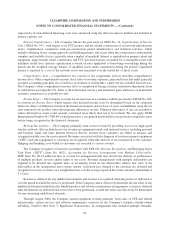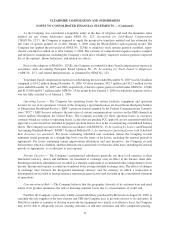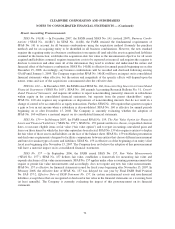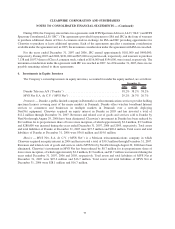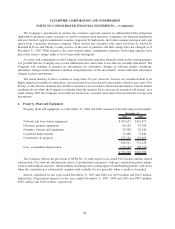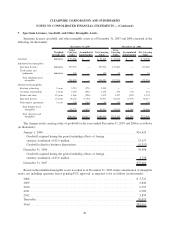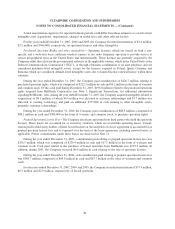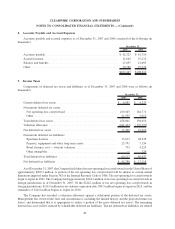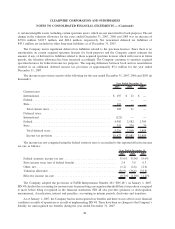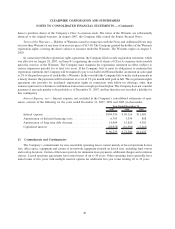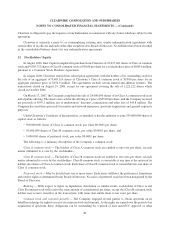Clearwire 2007 Annual Report Download - page 87
Download and view the complete annual report
Please find page 87 of the 2007 Clearwire annual report below. You can navigate through the pages in the report by either clicking on the pages listed below, or by using the keyword search tool below to find specific information within the annual report.At December 31, 2007, the Company held available for sale short-term and long-term investments with a total
fair value of $155.6 million and a cost of $162.9 million. During the year ended December 31, 2007, the Company
incurred other-than-temporary impairment losses and realized losses of $35.0 million related to a decline in the
estimated fair values of a number of short-term and long-term investment securities. Included in the Company’s
investments were auction rate securities with a fair value of $88.6 million and a cost of $95.9 million. Auction rate
securities are variable rate debt instruments whose interest rates are reset approximately every 30 or 90 days through
an auction process. The auction rate securities are classified as available for sale and are recorded at fair value.
Beginning in August 2007, the auctions failed to attract buyers and sell orders could not be filled. Due to
current market conditions, the Company is unable to estimate when the auctions will resume. When an auction fails,
the security resets to a maximum rate as determined in the security documents. These rates vary from LIBOR +
84 basis points to LIBOR + 100 basis points. While the Company continues to earn interest on these investments at
the maximum contractual rate, until the auctions resume, the investments are not liquid and it may not have access to
these funds until a future auction on these investments is successful. At December 31, 2007, the estimated fair value
of these auction rate securities no longer approximates cost and the Company recorded other-than-temporary
impairment losses and realized losses on its auction rate securities of $32.3 million for the year ended December 31,
2007. For certain other auction rate securities, the Company recorded an unrealized loss of $7.3 million in other
comprehensive income reflecting the decline in the estimated fair value of these securities. The Company considers
these declines in fair value to be temporary given its consideration of the collateral underlying these securities and
its conclusion that the declines are related to changes in interest rates rather than any credit concerns related to the
underlying assets. Additionally, the Company has the intent and ability to hold the investments until maturity or for
a period of time sufficient to allow for any anticipated recovery in market value.
In addition to the above mentioned securities, the Company holds one commercial paper security issued by a
structured investment vehicle that was placed in receivership in September 2007 for which an insolvency event was
declared by the receiver in October 2007. The Issuer invests in residential and commercial mortgages and other
structured credits including sub-prime mortgages. At December 31, 2007, the estimated fair value of this security
was $7.5 million based on the Company’s internally generated pricing models. During 2007 the Company
recognized losses of $2.5 million related to this commercial paper security. A restructuring plan for this security
is expected by mid 2008.
The Company estimated the fair value of these securities using internally generated pricing models that require
various inputs and assumptions and the Company also uses various methods including market, income and cost
approaches. Based on these approaches, the Company often utilizes certain assumptions that market participants
would use in pricing the investment, including assumptions about risk and or the risks inherent in the inputs to the
valuation technique. These inputs are readily observable, market corroborated, or unobservable. The Company
maximizes the use of observable inputs to the pricing models where quoted market prices from securities and
derivatives exchanges are available and reliable. The Company typically receives external valuation information for
U.S. Treasuries, other U.S. Government and Agency securities, as well as certain corporate debt securities, money
market funds and certificates of deposit. The Company also uses certain unobservable inputs that cannot be
validated by reference to a readily observable market or exchange data and relies, to a certain extent, on
management’s own assumptions about the assumptions that market participant would use in pricing the security.
In these instances, fair value is determined by analysis of historical and forecasted cash flows, default probabilities
and recovery rates, time value of money and discount rates considered appropriate given the level of risk in the
security and associated investor yield requirements. Extrapolation or other methods are applied to observable
market or other data to estimate assumptions that are not observable. The internally derived values are compared to
values received from brokers for reasonableness. The Company’s internally generated pricing models may include
its own data and require us to use judgment in interpreting relevant market data, matters of uncertainty and matters
that are inherently subjective in nature. The use of different judgments and assumptions could result in different
presentations of pricing and security prices could change significantly based on market conditions.
79
CLEARWIRE CORPORATION AND SUBSIDIARIES
NOTES TO CONSOLIDATED FINANCIAL STATEMENTS — (Continued)


